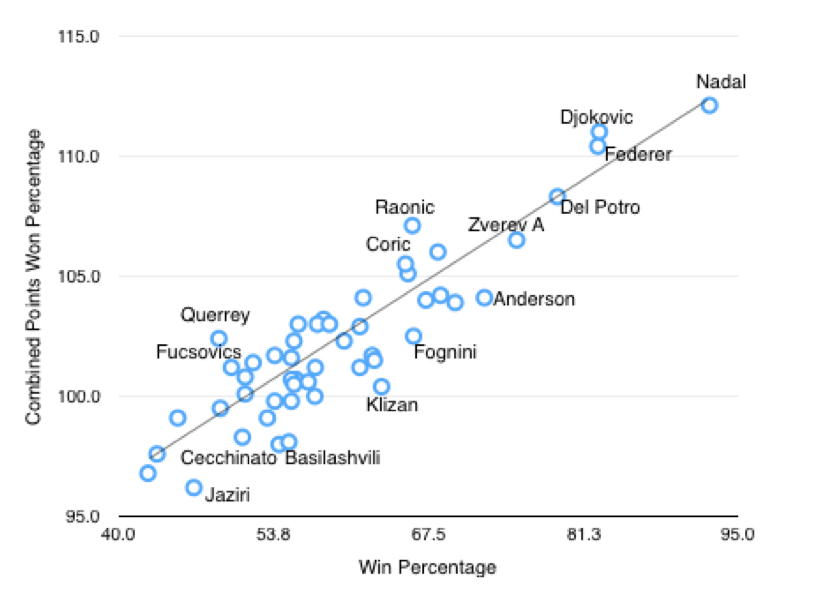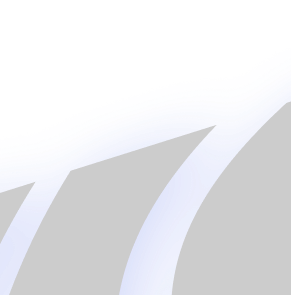Following next week’s Davis Cup, meaning that there is a week off from regular ATP tournaments, there are 12 events in a rather packed February schedule, mostly on indoor hard and clay courts. Considering this, there is plenty of scope for tennis betting opportunities after the Australian Open, meaning that there is no better time than now to discuss some strategy for player opposition.
The metrics
Previously among several mediums, we’ve looked at some strategies to identify players who have over or under performed several metrics, but here, we want to look at something a little more blunt and straightforward – which players have under or over performed from a simple win percentage perspective, compared to their combined points won percentages.
All-surface combined points won percentage (service points won percentage plus return points won percentage) is an excellent indicator of player level. It reflects a player’s dominance in a match – and indeed, other time scales as well, such as a season – with top players able to boast combined figures around 110% or greater, while below-average players fall below the 100% mark.
What does the data say?
Across the last 12 months, just two top 20 tennis players have a combined points won percentage of below 100% – Marco Cecchinato and Nikoloz Basilashvili – and interestingly, and also logically, they also have the two lowest all-surface match win percentages of the top 20 during that time period.
Further confirming the relationship between combined points won percentage and match win percentage are the top three players on tour – the traditional elite trio of Nadal, Djokovic and Federer – who all boast the highest three win percentages (all above 80%), as well as the highest three combined points won percentage (all above 110%).
Looking at lower-ranked players in tennis, 11 players in the top 50 have combined points won percentages below 100% – and seven are in the 40-50 ranking bracket – with the lowest being Malek Jaziri’s 96.2% combined percentage. The Tunisian is currently ranked at 43, and this is likely to mean that Jaziri is rather flattered by his current ranking.
The graph below illustrates the relationship between win percentage and combined points won percentage, across all ATP main draw matches, on all surfaces, in the last 12 months:

Here we can see that there is very little deviation for the vast majority of the players between their win percentage and their combined points won percentage, with the few players above the line having relatively better combined points won percentages than their win percentage, while the players below the line are flattered by their win percentage, based on their combined points won percentage.
Under and over performers
This would mean that the likes of Milos Raonic, Borna Coric, Sam Querrey and Marton Fucsovics have worse results than their combined points won percentages illustrate. Querrey in particular (102.4% combined points won, but just a 48.9% win percentage) looks like he’s massively underperformed based on his ability, and the American big-server could be one to provide some value in the future, assuming that he manages to mean-revert from this data.
Of the top players, Novak Djokovic looks like he’s a little better than his win percentage, and it will be interesting to see how this develops during 2019 given that the early part of 2018 was still rather tough for the world number one as he built his level back up on returning to the tour, while Rafa Nadal’s data – both from a win percentage and a combined points won percentage – is strongly influenced by his stellar clay performances. Having said this, Djokovic imposed a convincing win over Nadal in the Australian Open final, and it will be interesting to see the how the Spaniard’s upcoming performances will play out.
A number of players have relatively worse combined points won percentages compared to their win percentages, and these include Kevin Anderson, Fabio Fognini, Martin Klizan, Nikoloz Basilashvili, Marco Cecchinato and the aforementioned Jaziri.
Assuming mean-reversion, these players look likely to see a reduced win percentage in 2019 assuming they cannot improve on their combined points won percentage – these look like potential players to oppose in the not too distant future.







